Work Zone Training Webinar Louisiana Perspective
Printable Version [PDF 7.65MB]
You will need the Adobe Reader to view this PDF.
Contact Information: WorkZoneFeedback@dot.gov
slide 1
Work Zone Training Webinar Louisiana Perspective
Barry L. Lacy, P.E.
Work Zone/Claims/Audit Engineer

slide notes
None.
slide 2
Louisiana State Motto

slide notes
None.
slide 3
Why Is Temporary Traffic Control Important?
- People die
- People are injured
- Money is lost
- You and your company can be sued

slide notes
Key Message: Discuss the importance of TTC
Est. Presentation Time: 2 minutes
Explanation of Cues/Builds: None
Suggested Comments: TTC is important to the safety of EVERYONE!
Suggested Questions: What is the "4" inside the yellow box?
Additional Information: None
Possible Problems: None
slide 4
What Contractors (and DOTD) Wanted
- Get everyone (DOTD & contractors) "on the same page"
- Clear & concise information (not "at the discretion of the PE")
- Clear set of bid documents – no guessing on work zone safety (night work, # of devices, etc.)
- Get up to speed with the current standards – minimizes exposure in court
slide notes
None.
slide 5
Required Work Zone Training for Construction Inspection Personnel
Flagger
- All personnel (technicians & engineers)
TCT (Traffic Control Technician)
- The basics of temporary work zone traffic control
- All personnel (technicians & engineers)
TCS (Traffic Control Supervisor)
- Advanced temporary work zone traffic control
- All upper level technicians & engineers
- Louisiana Specific when available
slide notes
None.
slide 6
Required Work Zone Training for Construction Inspection Personnel (cont'd)
- ATSSA – preferred source of training
- Louisiana Specific Refresher Course (TCS) – will be ready soon with implementation this year
- Training records are readily maintained & tracked
- Certification not required – only course completion
- Refresher training required every 4 years
slide notes
None.
slide 7
Work Zone Training (DOTD & Contractors)
| Flagger | TCT | TCS |
|---|---|---|
| 2041 | 2552 | 2114 |
slide notes
None.
slide 8
Standard Specification
Section 713.08
Traffic Control Management
Important Points to Ponder
slide notes
None.
slide 9
Traffic Control Management
| Year | Cost |
|---|---|
| 2004–2005 | $177/Day |
| 2006 | $148/Day |
| 2007–on | Part of Temporary Signs & Barricades |
slide notes
None.
slide 10
Requirements
TCS shall have:
- a set of all contract documents relating to traffic control or traffic staging
- a current copy of the MUTCD
- a current copy of Louisiana Work Zone Traffic Control Details
slide notes
None.
slide 11
713.08(a) Authorization:
The contractor shall submit to the engineer a copy of the TCS's and TCT's current authorization.
Currently, ATSSA & AGC are acceptable, plus any others that contractors can justify.
Refresher course every 4 years required
slide notes
None.
slide 12
713.08(b) TCS Duties:
- TCS – may have other assigned duties, but must be readily available at all times to perform TCS duties as required in the contract
- A minimum of one TCT shall be required on site during working hours
- Someone in charge of traffic control (TCT or TCS) shall be on site at all times.
slide notes
None.
slide 13
713.08(b) TCS Duties: (cont'd)
- Responsible for the training of flagging personnel
- Ensures that all flagging done on the project is in compliance with the MUTCD and the Louisiana Work Zone Traffic Control Details
- Police – OK when used as flaggers, as long as they meet the flagger requirements and are being used ONLY as flaggers (not police)
slide notes
Do not abandon the job, not around police car, not talking on police radio, etc.
slide 14
Crashworthiness Letters (WZ Letter)

slide notes
None.
slide 15
713.08(d) Traffic Control Diary:
- TCS maintains a project traffic control diary online within Site Manager
- TCS keeps the traffic control diary current on a daily basis, and electronically signs each daily entry (contemporaneous)
- Subject to LA R.S. "Filing or Maintaining False Public Records"
- Failure to submit = $150/calendar day
slide notes
None.
slide 16
713.08(d) Traffic Control Diary: (cont'd)

slide notes
None.
slide 17
Excerpt From a Traffic Control Supervisor's Diary (not good)
"Came out today and had trucks set to go on different project. After getting this done, I left yard and went to plant in Metropolis, then went to Hwy 123 job where Jim had started laying binder mix. He had the first load on job site and I had about 11 other trucks hauling to him. I stayed until he got further down the road & had about 6 or 8 trucks unloaded. I also talked to the two girls unloading trucks and asked them to try and clean apron on trucks better. Went to Hwy 456, and got with Tom & Jerry to see what was going on, then came back to Hwy 789 on Jim's job, where I didn't get to see much except men asleep on job until I saw him at the store up the road. Came back to office for rest of day until time to go on. Had trucks set up for next day."
slide notes
None.
slide 18
713.08(e) Inspection of Traffic Control:
- TCS – responsible for the inspection of all traffic control devices every calendar day
- Inspection may be delegated to the TCT, except on high profile/speed/ADT (TCS)
- The "Quality Guidelines for Work Zone Traffic Control Devices" (ATSSA) – used to evaluate the condition of the traffic control devices to determine if acceptable for use
slide notes
None.
slide 19
ATSSA Quality Guidelines Distribution
- 600 pamphlets to DOTD personnel
- 200 pamphlets to 70 different contractors
- Distributed since 2005
Acceptable/Marginal/Unacceptable

slide notes
Given out at lettings, mailed, etc.
slide 20
713.08(e) Inspection of Traffic Control:
- Inspected by the TCS on weekends, holidays, or other non-work days at least once per day
- Inspected by the TCS at least once a week during nighttime periods
slide notes
None.
slide 21
713.08(f) Failure to Comply:
- PE, Work Zone Engineer, or Statewide Traffic Control Specialist – may suspend all or part of the contractor's operation(s) for failure to comply with the approved "Traffic Control Plan" or failure to correct unsafe traffic conditions within a reasonable period of time
- Notification is given to the contractor in writing
- Serious deficiencies shall constitute in the contractor's operations being shut down until such time as he can demonstrate that he can meet the specification in its entirety
slide notes
None.
slide 22
Inspection Deficiencies
- Major = 2 pts, Minor = 1 pt
- Signs
- Major – not clipped in properly, wrong application, not telling the truth, using burlap to cover signs
- Minor – incorrect spacing/sheeting/size/posts
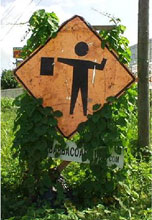
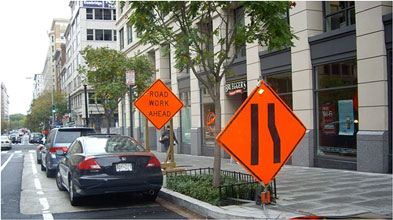
slide notes
None.
slide 23
You can see through burlap at night!
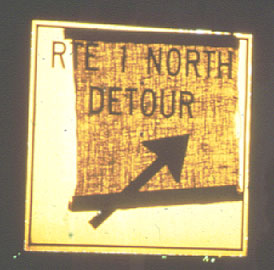
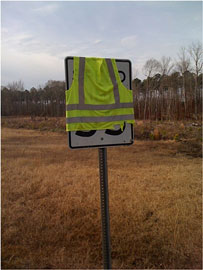
slide notes
Key Message: Burlap is not an acceptable covering
Est. Presentation Time: Less than 1 minute
Explanation of Cues/Builds: None
Suggested Comments: You can see through burlap. Light bounces back!
Suggested Questions: None
Additional Information: Photo sources unknown
Possible Problems: None
slide 24
Inspection Deficiencies
- Barricades
- Major – not crashworthy
- Minor – chevrons pointed in wrong direction

slide notes
None.
slide 25
Inspection Deficiencies (cont'd)
- Flagging Operations
- Major – not qualified, wrong location, no lime green vest
- Minor – pole too short (6'), sign too small (<18")
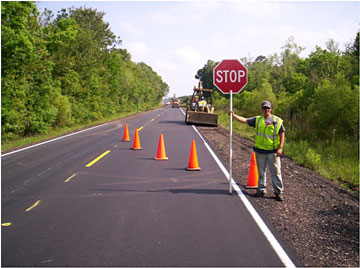
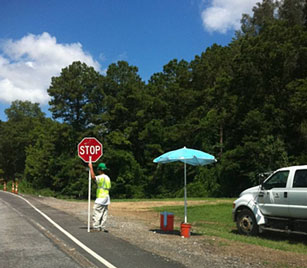
slide notes
None.
slide 26
Qualified Flagger??

slide notes
None.
slide 27
Inspection Deficiencies
- Message Signs/Arrow Boards
- Major – wrong message, misapplication (taper, flagger, etc.)
- Minor – no delineation, using them as an arrow board
slide notes
None.
slide 28
Appropriate Work Zone Message??

slide notes
None.
slide 29
Using Message Board as Arrow Board??

slide notes
None.
slide 30
Inspection Deficiencies
- Miscellaneous
- Major – ballast tied to moveable stand (not crashworthy), equipment parked in clear zone, incorrect flare for concrete barriers (outside to clear zone or crash cushion), taper too short, TMAs not being moved as the work moves down the highway
- Minor – wrong speed limit or lights, unkept roadway

slide notes
None.
slide 31
Incorrect Placement of TMAs?

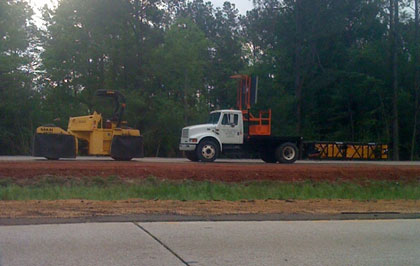
slide notes
None.
slide 32
Tapers Too Short??
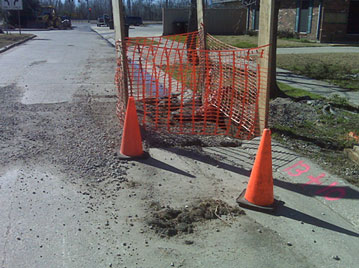
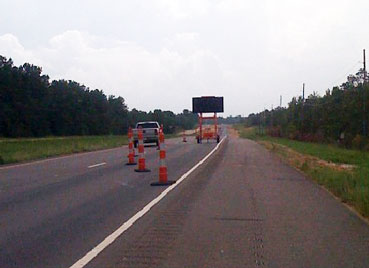
slide notes
None.
slide 33
Non-reflectorized Netting??

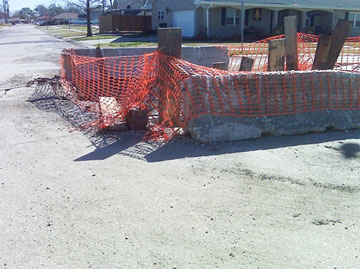
slide notes
None.
slide 34
Crashworthy??
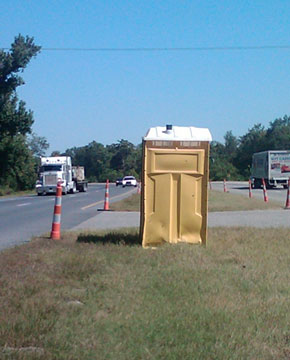
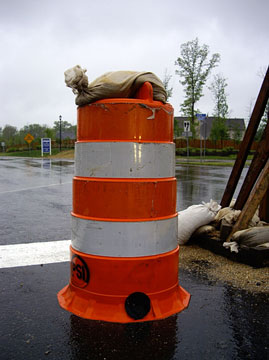
slide notes
None.
slide 35
713.08(f) Failure to Comply:
- We reserve the right to revoke or de-certify the TCS for gross neglect of his or her duties.
- "certification is a privilege"
- "safety hazard to the workers and the public"
- "violated procedures and practices of the MUTCD"
- TCS retakes TCS course – subject to a 90 day probationary period at the discretion of the Department
- Approximately 12 TCSs decertified in the last 1½ years – some companies have demoted or fired these individuals
slide notes
None.
slide 36
Protecting Blunt Ends When Removing Guardrail
- Old method – Type III barricade & 3 devices – NO PROTECTION!!
- Option 1 – Remove & replace guardrail the same day
- Option 2 – Install and maintain an NCHRP 350 TL-3 or MASH approved device until new guardrail is installed
- Non-NHS routes with shoulders less than 8 feet wide – if TL-3 cannot be installed due to field conditions, TL-2 is acceptable
- New guardrail should be installed within seven (7) days.
slide notes
None
slide 37
The Bottom Line
- Take pride in your work zone
- Have workers wearing appropriate safety garments (not worn or ragged) – they will command more respect from the traveling public
- Establish a work zone that any driver (young or old) could navigate easily
- TTC sets the tone for the entire project – if it doesn't look good or isn't correct, motorists won't respect you, and expect sloppy inspection & construction
- TTC is your controlling work item each and every day!!!
slide notes
None
slide 38
Louisiana's Construction Budget?

slide notes
None.
slide 39
Questions?
Barry L. Lacy, P.E.
Work Zone/Claims/Audit Engineer
barry.lacy@la.gov
(225) 379-1584

slide notes
None.